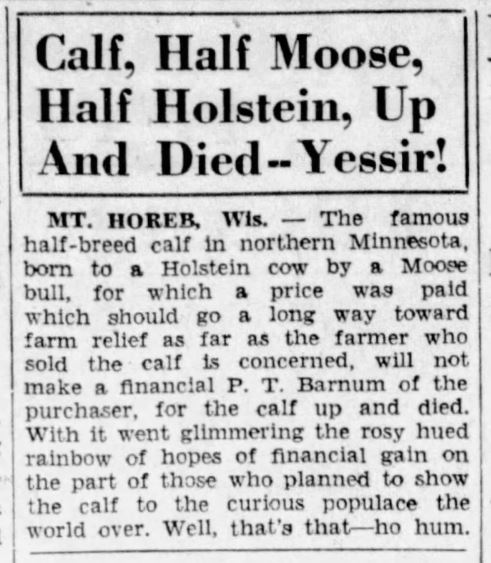Moose-cow Hybrids
Mammalian Hybrids
 Photo of an ostensible moose-cow hybrid (possibly a pure moose with a rare, cow-like coat pattern?) taken at Fahler, Alberta, and sent in by a local ranger.
Photo of an ostensible moose-cow hybrid (possibly a pure moose with a rare, cow-like coat pattern?) taken at Fahler, Alberta, and sent in by a local ranger.
EUGENE M. MCCARTHY, PHD GENETICS, ΦΒΚ
|
A diligent scholar is like a bee who takes honey from many different flowers and stores it in his hive.
—John Amos Comenius
|
In the October 1939 issue of Journal of Heredity, two veterinarians at the University of Minnesota, W. W. Green and Robert Fenstermacher, describe a probable hybrid of this type (Green and Fenstermacher 1939†; also see editor’s comments on page 457 of the same issue). The external features of the animal indicated mixed parentage, though overall it was more like a cow than a moose. The mother, a dairy cow on a farm located a few miles north of Duluth, Minnesota, apparently mated in the fields with a bull moose. The calf was blind; Green and Fenstermacher note that “upon autopsy it was found that the lens portion of the eyes was either deficiently developed or absent.” The eyes were preserved for later study, so it may be that tissue is still available for molecular genetic testing. Congenital blindness, anophthalmia and cyclopia occur at elevated rates in distant hybrids.
From time to time, news stories about mismatched moose-cow couples also appear. One was “Bullwinkle, The Lovesick Moose,” by reporter Jim Wright, published in the Charleston, SC, News and Courier, on Dec. 11, 1986 (p. 14-A), from which the following material is quoted, relates the escapades of a bull moose (Bullwinkle) and his lady love, the patient cow Jessica. "Several weeks ago during the regular rutting season, Bullwinkle, formerly a sober, responsible member of the Vermont moose community, suddenly
went off the deep end for a comely Hereford cow named Jessica. She lives in a pasture owned by farmer Larry Carrara of Shrewsbury, Vt.
Though Bullwinkle is wild, as well as crazy, he began hanging around Jessica's place, attempting to make time with her. He went through the usual routine for impressing a chosen member of the fair sex: Bellowing, pawing the ground, strutting around, probably flexing, posing and trying to be cool. She, being a Hereford lady and a proper Vermonter to boot, was having none of that, since they had not been introduced.
...Rutting season came and went, but the lovesick moose lingers on in Carrara's pasture. We are not talking about one-night stands here; this moose is thinking in terms of community property arrangements.
Cervid-bovid crosses:
According to the Associated Press correspondent on the scene, Bullwinkle has ceased pressing his suit with the direct approach, and has calmed down considerably. From the description of his behavior, it is clear that he has fallen back on the old waiting game, sometimes known as the "dazzle 'em with chivalry" number. He is mooning around, dancing attendance on Jessica, nudging other cows away from the feed so that she can eat first. No doubt by now, he is opening doors for her and spreading his cloak over mud puddles, trying to show he's a one-cow moose.
From the Great Falls, Montana, Tribune (May 23, 1939, p. 7, col. 3; ||rhfl38r):

From the Minneapolis, Minnesota, Star Tribune (Feb. 20, 1931, p. 3; ||y3684ayh):

This news story, which tells of the demise of the animal described in the previous report, is from the Madison, Wisconsin, Capitol Times (Apr. 19, 1931, p. 24, col. 2; ||yxcezaz9):

This item of Nova Scotia news appeared in the Montreal Gazette (Dec. 27, 1878, p. 3, col. 2; ||y6r3tnj6):

From the Pittsburgh Sun-Telegraph (May 9, 1943, p 77; ||r8x68lg):

The following is a report about the production of moose-cow hybrids in the Gatineau River Valley north of Ottawa in the 1940s. Taken from the February/March 2005 issue of the Gatineau Valley Historical Society Newsletter. If correct, this report indicates that male hybrids of this type can sometimes be fertile, which (by Haldane’s Rule) suggests that female hybrids of this type are also capable of producing offspring.


From the Ottawa Journal (Apr. 14, 1946, pp. 1-2; ||u6h7qww):


More about the moose-cow hybrids produced north of Ottawa in the 1940s. Taken from the April/May 2005 issue of the Gatineau Valley Historical Society Newsletter:

By the same author: Handbook of Avian Hybrids of the World, Oxford University Press (2006).
Most shared on Macroevolution.net:
Human Origins: Are we hybrids?
On the Origins of New Forms of Life
Mammalian Hybrids
Cat-rabbit Hybrids: Fact or fiction?
Famous Biologists
Dog-cow Hybrids
Prothero: A Rebuttal
Branches of Biology
Dog-fox Hybrids
